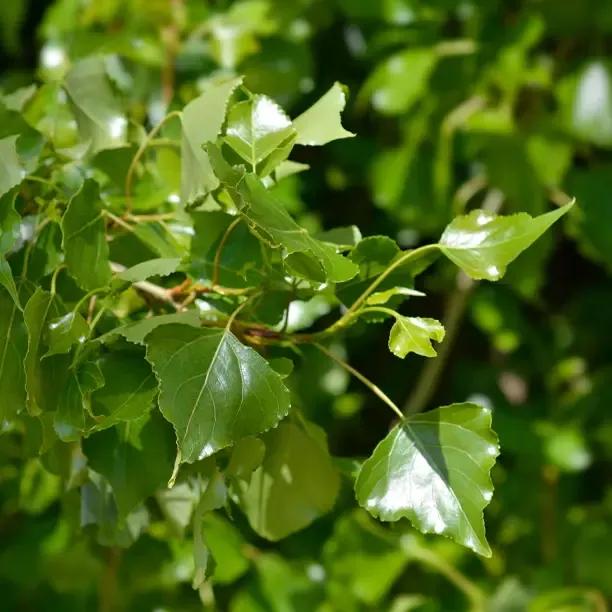Native Black Poplar Sapling Trees
Honest Delivery Prices- Native.
- Not suitable for clipped hedging.
- Likes damp sites.
- Max Height 25m
- Bareroot delivery only.
Recommended extras
Description
Black Poplar Plants - Delivered by Mail Order from the Nursery with a 1 Year Guarantee
Black Poplar, Populus nigra Betulifolia, is the native english Black Poplar that was though to be extinct but has been rediscovered.
Black Poplar is not suitable for a clipped hedge.
It can be grown as a screening tree up to about 25 metres high.
We are not able to determine the sex of your trees before delivery, but they are more likely to be male than female.
Black Poplar plants are only delivered bareroot, during winter (Nov-March).
All of our young trees and shrubs are measured by their height in centimetres above the ground (the roots aren't measured).
General description of Populus nigra Betulifolia plants:
Sometimes called the Manchester, Midland or Atlantic Black Poplar, it is a deciduous, native tree with a thick trunk and branches that are covered in bristly, densely packed twigs. Some of the lower branches arch downwards, which helps form a rounded head although many trees acquire a much bushier shape that has a charm all of its own.
Older trees develop thick, gnarled trunks that often produce large burrs, which are a mass of twisted wood fibres that sticks out from the side of the tree. Burrs are generally quite rare and are are prized by craftspeople who work with wood, especially sculptors, because the swirling lines of the grain can be used to create unique and striking effects.
Planting Instructions
Notes on planting Black Poplar:
Populus nigra betulifolia will grow in any rich, fertile soil type, including chalk as long as it is not also dry with a shallow topsoil. Prune in winter, when all the leaves have fallen. This poplar is pollution resistant and was planted so widely in the Midlands and the North during the industrial revolution it became known as the Manchester Poplar. It will grow to about 25 metres, 80 feet, tall and the canopy can often be as wide.
Prepare your site before planting:
It is good to dig over the area where you intend to plant several months in advance. Destroy the weeds first: nettles, brambles and ground elder are tough. Then dig the soil over; remove rocks, roots and other rubbish. Mix in well rotted compost or manure down to the depth of about 2 spades.
If you have a heavy clay soil, it might be too difficult to dig over for most of the year. Heavy clay is fertile soil, so you don't really need to improve it; killing the weeds is still necessary.
Remember to water establishing plants during dry weather for at least a year after planting.
Planting accessories:
Prepare your site for planting by killing the weeds and grass.
If you are planting in an area with rabbit and/or deer, you will need to use a protective plastic spiral for each plant, supported by a bamboo cane.
If your soil quality is poor, we recommend using mycorrhizal "friendly fungi" on the roots of new trees and shrubs.
After Care
After you plant your Black Poplar trees, the most important thing to do is water them in dry weather. You will also need to weed around the plants. Both of these will be necessary for at least a year after planting.
Water thoroughly but not too often: let the soil get close to drying out before watering your plants again.
Special notes on caring for Black Poplar:
Black Poplar is a very tough plant that shouldn't need special attention once it has established. If pruning is necessary, it is best do it in winter. Always hire a tree surgeon to remove large branches.
Hygiene & Diseases:
Dead, damaged or diseased wood can be pruned off as soon as it appears.
Disinfect your pruning tools between every cut if there is any sign of disease.
Burn or dispose of any diseased material, do not compost it.
After you plant your Black Poplar trees, the most important thing to do is water them in dry weather. You will also need to weed around the plants. Both of these will be necessary for at least a year after planting.
Water thoroughly but not too often: let the soil get close to drying out before watering your plants again.
Special notes on caring for Black Poplar:
Black Poplar is a very tough plant that shouldn't need special attention once it has established. If pruning is necessary, it is best do it in winter. Always hire a tree surgeon to remove large branches.
Hygiene & Diseases:
Dead, damaged or diseased wood can be pruned off as soon as it appears.
Disinfect your pruning tools between every cut if there is any sign of disease.
Burn or dispose of any diseased material, do not compost it.


